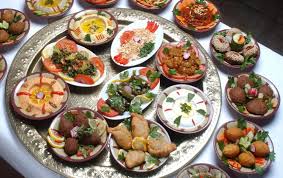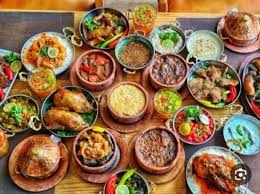Egyptian food is a flavorful reflection of the country’s history, geography, and culture. From the fertile Nile Valley to bustling city markets, Egypt’s cuisine blends fresh vegetables, hearty grains, aromatic spices, and traditional cooking techniques passed down through generations. Whether you’re wandering the streets of Cairo, exploring Luxor, or relaxing in Aswan, you’ll find dishes that are both comforting and bursting with flavor.
Staple Foods in Egypt
Bread is at the heart of Egyptian cuisine. Known locally as eish, bread is eaten with almost every meal. Popular varieties include:
Eish Baladi – A whole wheat pita-style bread, considered the national bread of Egypt.
Eish Fino – A softer, baguette-like bread.
Eish Merahrah – A traditional flatbread made with fenugreek seeds.
Eish Shamsi – A sun-baked bread popular in Upper Egypt.
Vegetables, legumes, and beans form the foundation of many dishes, making Egyptian cuisine naturally rich in plant-based options. Meat is enjoyed but often reserved for special occasions, while seafood is a favorite in coastal regions like Alexandria.
Egyptian Spices and Flavors
Spices are essential to Egyptian cooking, adding depth and aroma to even the simplest dishes. Common spices and herbs include:
Cumin Coriander Cinnamon
Cardamom Aniseed Dill
Bay leaves Dill Cinnamon
Parsley Ginger Mint
These seasonings not only enhance flavor but also connect modern recipes to ancient culinary traditions.
Popular Egyptian Meat Dishes
While many meals are vegetarian, meat dishes are a cherished part of Egyptian cuisine. Common proteins include lamb, beef, chicken, duck, rabbit, and pigeon (hamam). Offal—organ meats—is also popular as a street food snack.
Famous Egyptian Dishes
Ful Medames – A national breakfast dish made from slow-cooked fava beans, flavored with olive oil, lemon juice, and cumin, served with bread.
Ta’ameya (Egyptian Falafel) – Made with fava beans instead of chickpeas, blended with herbs and fried until crispy.
Koshari – Egypt’s most famous street food, combining rice, lentils, macaroni, and chickpeas, topped with spiced tomato sauce and crispy onions.
Molokhia – A green soup made from finely chopped jute leaves, often served with chicken or rabbit and eaten with rice or bread.
Fatteh – A festive dish of rice, lamb, and crispy bread pieces, covered in a tangy tomato or vinegar-based sauce.
Bamia – A slow-cooked stew of okra, lamb, and tomatoes.
Shawarma – Thin slices of marinated meat cooked on a vertical rotisserie, wrapped in pita bread with tahini sauce.
Mahshi – Vegetables such as zucchini, eggplant, and grape leaves stuffed with rice and herbs.
Salads and Starters
Egyptian meals often start with light salads and appetizers, such as:
Salata Baladi – A fresh mix of cucumber, tomato, and herbs.
Hummus – A smooth chickpea dip with tahini and lemon.
Baba Ghanoush – A smoky roasted eggplant dip.
Local cheeses such as Domiati.
Egyptian Desserts
Egypt is also famous for its sweet treats:
Basbousa – A semolina cake soaked in syrup.
Kunafa – Thin pastry threads layered with cream or cheese, soaked in syrup.
Umm Ali – A bread pudding with milk, nuts, and raisins.
Atayef – Stuffed pancakes often served during Ramadan.
Kahk – Festive cookies filled with dates or nuts.
Ancient Egyptian Culinary Traditions
Egypt’s food culture has deep roots in ancient history. Thousands of years ago, bread and beer formed the core diet for all social classes. Onions, legumes, vegetables, and fruits like dates and figs were everyday staples, while meats and imported spices were enjoyed by the wealthy. Many ancient recipes—such as molokhia and fava bean stews—are still eaten today.
Banquets in ancient Egypt were lavish affairs, often linked to religious celebrations, with offerings made to the gods and the dead. Food was not just sustenance; it was a symbol of life, community, and faith.
Egyptian Drinks
Tea is Egypt’s national drink, enjoyed both black and with fresh mint. Coffee is also popular, while beer is the most common alcoholic beverage. Although alcohol is avoided by many for religious reasons, it is still available in major cities.
Final Tips for Enjoying Egyptian Food
Try eating at local restaurants for authentic flavors.
Be cautious with street food if you have a sensitive stomach.
Pair your meals with fresh juices, hibiscus tea (karkade), or mint tea.
Egyptian cuisine offers a vibrant mix of history, flavor, and hospitality. Whether you’re savoring koshari in Cairo or tasting feteer meshaltet in Luxor, each bite is a journey into Egypt’s rich cultural heritage.



